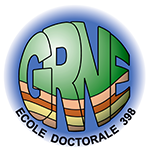Séminaire ISTeP - John Wakabayashi
(CSU Fresno, Prof. invité ISTeP)
Anatomy of a subduction complex: Architecture of the Franciscan Complex at multiple length and time scales
The Franciscan Complex of California records over 150 million years of continuous east-dipping subduction that terminated with conversion to a dextral transform plate boundary. The Franciscan comprises mélange and coherent units forming a stack of thrust nappes, with significant along-strike variability, and downward-decreasing metamorphic grade and accretion ages. The Franciscan records progressive subduction, accretion, metamorphism, and exhumation, spanning the extended period of subduction, rather than events superimposed on pre-existing stratigraphy. High-pressure (HP) metamorphic rocks lack a thermal overprint, indicating continuity of subduction from subduction initiation at ca. 165 to termination at ca. 25 Ma. Accretionary periods may have alternated with episodes of subduction erosion that removed some previously-accreted material, but the complex collectively reflects a net addition of material to the upper plate. Mélanges (serpentinite and siliciclastic matrix) with exotic blocks have sedimentary origins as submarine mass transport deposits, whereas mélanges formed by tectonism comprise disrupted ocean plate stratigraphy and lack exotic blocks. The former are interbedded with and grade into coherent siliciclastic units.
Paleomegathrust horizons, separating nappes accreted at different times, appear restricted to narrow zones of <100 m thickness. Exhumation of Franciscan units, both coherent and mélange, was accommodated by significant extension of the hanging wall and cross-sectional extrusion. The amount of total exhumation, as well as exhumation since subduction termination, needs to be considered when comparing Franciscan architecture to modern and ancient subduction complexes. Equal dextral separation of folded Franciscan nappes and late Cenozoic (post-subduction) units across strands of the (post subduction) San Andreas fault system shows that the folding of nappes took place prior to subduction termination. Dextral separation of similar clastic sedimentary suites in the Franciscan and the coeval Great Valley Group forearc basin is approximately that of the San Andreas fault system, precluding major syn-subduction strike-slip displacement within the Franciscan.
07/05/2015 à 12h30, Salle Fourcade (Tour 55/56, 4ème étage)
Egalement dans la rubrique
- Séminaire ISTeP - Chrystèle Sanloup
- Séminaire ISTeP - Marco Scambelluri
- Séminaire ISTeP - Déborah Chavrit
- Séminaire ISTeP - Evgueni Burov
- Séminaire ISTeP - Anne Le Friant
- Séminaire ISTeP - Pierre Valla
- Séminaire ISTeP - Ramadan Ghalayini
- Séminaire ISTeP - Matthias Delescluse
- Séminaire ISTeP - Séverine Moune
- Séminaire ISTeP - Lucie Tajcmanova
- Séminaire ISTeP - Gabriel Coelho
- Séminaire ISTeP - Laurie Bougeois
- Séminaire ISTeP - Jacques Touret
- Séminaire ISTeP - Sanae El Janyani
- Séminaire ISTeP - Arthur Paté
- Séminaire ISTeP - Nicolas Beaudoin
- Séminaire ISTeP - Kosuke Ueda
- Séminaire ISTeP - Ali Hannouche
- Séminaire ISTeP - Benjamin Cochain
- Séminaire ISTeP - Behzad Nasri
- Séminaire ISTeP - Daniel Pastor Galan
- Séminaire ISTeP - Sara Lafuerza Colas
- Séminaire ISTeP - Jean-Pierre Suc
- Séminaire ISTeP - Pierpaolo Zuddas
- Séminaire ISTeP - Agnès Elmaleh
- Séminaire ISTeP - Jonas Ruh
- Séminaire ISTeP - Timm John
Chiffres clés (Mars 2025)
L'ISTeP comprend 131 membres dont :
Permanents (66)
- Professeurs : 17 (+2 PAST)
- Maîtres de conférence : 26
- Directeurs de recherche CNRS : 1
- Chargés de recherche CNRS : 1
- ITA : 19
Personnels non permanents (65)
- Collaborateurs bénévoles / émérites : 17
- Chaire de professeur junior : 1
- Enseignants-chercheurs contractuel : 2
- 1 MCF accueil en délégation
- ATER et Post-Docs : 9
- Doctorants : 32
- ITA-BIATSS : 3





